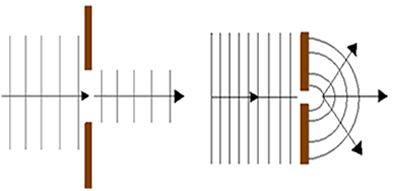When we drop a stone onto the surface of a liquid, we will see ripples forming in the form of concentric circles. We call these ripples waves, which, because they have small amplitudes, we consider transverse waves. In the ensuing motion of these waves, they can either be reflected or they can be refracted.
The phenomenon called diffraction it is nothing more than the deviation or scattering suffered by the wave when it circumvents or transposes obstacles placed in its path. We can say that this phenomenon happens to all types of waves and is easily noticeable in the case of sound waves. An example of sound diffraction is when we are listening to music being played on the other side of a wall.
The greater or lesser capacity of a wave to undergo diffraction is related to the size of the obstacle to be circumvented or the width of the passage to be traversed and its wavelength.
The diffraction will be more intense the longer the wavelength is compared to the size of the obstacle. In other words, the wave more easily bypasses obstacles when they are small compared to the wavelength of the waves.

This phenomenon, as well as reflection and refraction of waves, can be explained based on the Huygens' principle. Huygens' principle can be applied to any type of wave and is used to determine the position of a wavefront at a given time, as long as its position is known at an earlier time.
By Domitiano Marques
Graduated in Physics


